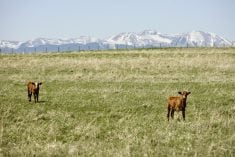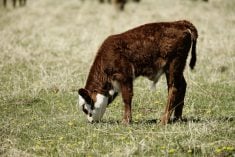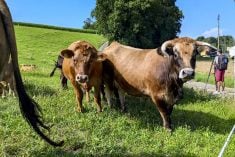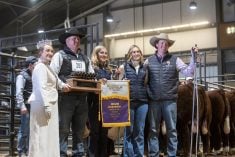My curling buddy is one of the best young cow-calf managers that I know. I recently asked him what his management strategies were for having a successful calving season.
“The No. 1 issue is buying the best bull you can find,” my friend said. “Pay the extra money to get a top-performing bull as he will be leaving a lot of daughters in your herd. There are cow lines in breeders’ herds that are noted for easy calving. Some of these cow families have short gestation periods and calve about two weeks before their due date. That means that you will get a lighter birth weight as the fetus will grow a lot during the last part of the trimester. This results in easy calving.”
Read Also

Body condition, nutrition and vaccination for brood cows
One of the remarkable events of the past century related to ranching has been the genetic evolution of brood cows….
He went on to say, “A good cow will leave you about 10 calves in your herd. You need to figure out what you need the bull to do. Is it easy calving, high weaning weights, or is it a terminal breed? I spend a lot of time before buying bulls evaluating the breeder’s herd. I need to actually see the mothers of the bulls that I am purchasing to see if that is the type of female that I want in my herd. I also analyze the management of the herd to see if it fits with my needs, then I pay the extra money for the bull that meets all my needs. I don’t buy average-priced bulls as that’s what I am going to get… just average performance. I don’t like pulling calves in the middle of the night so easy calving bulls is most important.
“Before the calving season I get rid of any wild cows and I also cull open cows and those with bad udders and feet. However, over the years when I selected good bulls I reduced my udder and feet and performance problems by keeping the offspring. All my cows are vaccinated with scour prevention vaccine prior to calving. I provide lots of bedding in a sheltered area as I calve in April in central Alberta and we still get snow- and rainstorms. The big thing is to keep the newborn calves dry and give them lots of room in a clean area. I don’t have a scour problem and if I do I use lots of electrolytes. With good herd health, nutrition and a proper mineral program as recommended by my nutrition consultant and veterinarian I don’t have problems at calving time. The cows basically calve on their own, but I do check the heifers about every four hours throughout the calving season.”
My friend concludes, “Do you really want your future females in your herd from a $2,500 bull or from a $4,500 bull? Pay the extra money for a top-performing bull, it’s well worth it.”
In addition to visual traits in genetic selection, genomic information on the DNA will also play a vital role in improving the accuracy of breeding values for many hard-to-measure traits and also increase the rate of genetic improvement in the beef cattle industry.
There is a lot of research going on this topic and Dr. John Basarab with Alberta Agriculture at the Ag and Agri-Food Canada Lacombe Research Centre is part of a Canadian genomics team that is working on identifying feed-efficient bulls and cows for residual feed intake or low RFI.
Basarab says, “One of the things that I have been seeing at calving time is a trend to having a lower death loss of calves up to 30 days of age in the cows that have a higher feed efficiency (-RFI). I think that this could be caused by one of the biological mechanisms controlling feed efficiency. The more feed-efficient cows use less energy for maintenance and more energy is available for production and a better uterine environment. At the cellular level, there could be a difference between efficient and less efficient females in cell-mediated immunity leading to inefficient dams and their offspring being more susceptible to stressful conditions. Calving difficulty, age at first calving, calf birth weight, calf pre-weaning ADG, calf actual and 200-d weaning weight and heifer and cow productivity expressed as kg calf weaned per cow exposed to breeding, were also similar for the higher-feed-efficient (-RFI) and less-feed-efficient (+RFI) heifers and cows.”
The replacement RFI heifers were tracked for several years, but during their third winter when grazing stockpiled forages for the first time there was a difference between the efficient cows and the less efficient cows in body weight and backfat thickness. The more efficient cows (-RFI) were 30-35 kilograms heavier and had two to three mm more backfat than the less efficient cows (+RFI) prior to calving.
“We did see the more efficient first-calf heifers calving five to six days later in the calving season than the less efficient first-calf heifers and this could be caused by a delayed estrus resulting in a delayed conception during the first breeding season. Thereafter the calving interval and gestation length were similar to less efficient (+RFI cows). This delay in estrus is primarily the result of when we measure feed intake and that is during the time when heifers are coming into puberty (eight-13 months of age). Heifers that have reached puberty during the feed intake test period are consuming about two to five per cent more feed energy due to sexual activity and sexual development compared to non-cycling heifers; thus the test tends to favour later-maturing or later-fattening heifers. We attempt to control this by adjusting RFI for off-test ultrasound backfat thickness and selecting only those heifers that become pregnant during a 42-day breeding season. Calf birth and weaning weights were similar between the feed-efficient and less efficient cows
“Selecting for feed-efficient bulls and cows is not the only trait you look at in selecting a bull,” he says. “You need to look at many other traits as related to your herd. The estimated breeding value or EPD is still important. A feedlot profitability index will provide you with bulls with good growth, and good feed efficiency with a balance of carcass traits, while the maternal productivity index will help to consistently wean heavy calves over a sustained herd life while controlling cow feed costs. You need to set breeding goals such as increase genetic potential of market progeny for feedlot profit or consistently wean heavy calves over a sustained herd life, while controlling for cow feed requirements. RFI or feed intake will play a role in both breeding goals, and their importance will be determined by the economic weighting being placed on them by the breeder or seed stock group. “If you are at the bull sale and looking for a bull to breed heifers look at calving ease and low birth weights but also look at fertility traits such as weaning weights, milk production, feed efficiency information and if possible know the cow herd and reputation of the breeder.
From the Manitoba Co-operator website: All boys or all girls?
“In the future there will be a continued need to individually test bulls for feed efficiency. This means that bulls on test must be individually fed for feed consumption and performance data. The different breed associations in Alberta are currently testing bulls at several testing facilities in the province and these bulls will be available to the industry. However, there is limited testing elsewhere in Canada. The information on feed-efficient bulls or RFI values will be calculated into a multi-trait selection index with economic values and this will help make the estimated breeding values more useful in the future.
Basarab concludes, “The Canadian beef industry will need to continue measuring feed intake in their bulls. The breed associations across Canada and the seed stock organizations need to work together to create feedlot profitability indexes and maternal productivity indexes along with feed efficiency information and promote this information to their customers.”
Trying to decide on the actual time of the calving season presents many options. When we started Canada’s first “Pasture to Plate” cow-calf and pasture program at the Melfort Research Station in Saskatchewan during the early ’70s, we looked at Jan., Feb. versus April and May calving seasons. Later we moved the herd to Feb.-March calving. Currently at Lacombe we are looking at April and Sept. calving.
We’ve also done a lot of calving research in different weather environments. One of the major things that we developed at Melfort was a portable calving shelter that could be moved around to different areas during the calving season. It was made from a drill stem and contained three calving pens complete with head gates and portable infrared heaters. We calved cows successfully in these units in weather that sometime dipped to -30 C. The plans can be found on www.Foragebeef.ca along with all sorts of calving management information.
Many producers don’t want to calve in snowstorms and are looking at calving on grass as a means of lowering labour requirements and costs. The Western Beef Development Centre and the Brandon and Swift Current Research Centres conducted a trial to evaluate the effect of March and June calving on subsequent performance during the backgrounding and finishing phases under a rapid-finish versus slow-finish feeding program.
The rapid-inished steers were fed a backgrounding diet followed by high-barley grain in the feedlot while the slow-finished steers were fed a backgrounding diet in the feedlot during the winter followed by grazing during the summer and later finished on a high-barley grain finishing diet. Once steers met the desired end point of 0.3 inches (eight mm) backfat or 1,650 lbs. bodyweight they were sent for slaughter.
The cows that calved in June remained on extended grazing systems longer than cows calved in March without compromising performance, resulting in a lower feed cost per cow per day.
Different finishing systems had a greater impact on the performance of March-born steers. This was related to the duration of the backgrounding period. A longer backgrounding period reduced overall gains and efficiencies, but increased final weights. March-born calves appeared to be more suited to the rapid-finishing system and June-born calves showed greater flexibility in adapting to the two finishing systems. Again, this was due to the shorter time required to background June- versus March-born calves. The researchers concluded that cow-calf producers will need to consider their post-weaning management practices as well as the target markets for their weaned calves when selecting calving seasons.
Managing a successful cow-calf operation really begins before calving season. It begins with buying the right bull, and choosing the best time to calve in terms of your weather, available labour and marketing plans.
Duane McCartney is a retired forage beef systems research scientist in Lacombe, Alta.
















